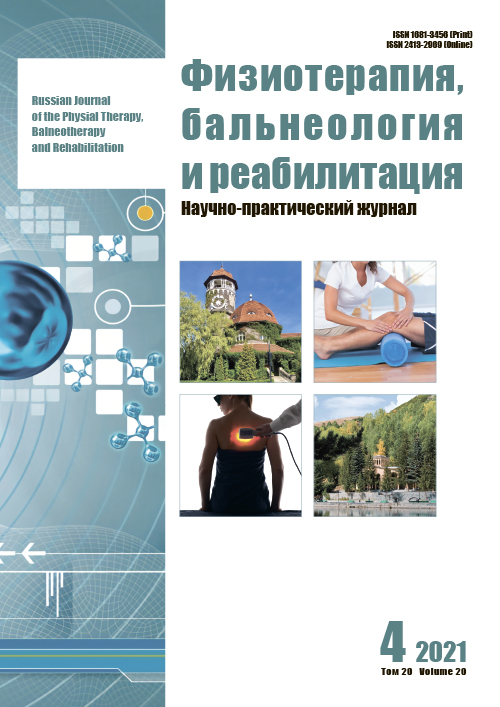Clinical efficacy of electrophoresis of hydrobiont collagenase isoenzymes at the rehabilitation stage in women with vulvar lichen sclerosus
- Authors: Ignatovskiy A.V.1,2, Kruglova L.S.3
-
Affiliations:
- Academician I.P. Pavlov First St. Petersburg State Medical University
- Dermatology and Reproductive Health Clinic of Dr. Ignatovsky
- Central State Medical Academy of Department of Presidential Affairs
- Issue: Vol 20, No 4 (2021)
- Pages: 297-302
- Section: Original studies
- Published: 15.07.2021
- URL: https://rjpbr.com/1681-3456/article/view/63806
- DOI: https://doi.org/10.17816/rjpbr63806
- ID: 63806
Cite item
Abstract
BACKGROUND: Due to insufficient effectiveness of currently known methods of treatment of patients with scleroatrophic lichenes of the vulva, as well as the lack of reasonable ways to manage patients at the stage of rehabilitation, there is a need to search for new approaches to solve this problem.
AIMS: to study the possibility to apply electrophoresis of the enzyme preparation from hydrobiont collagenases at the stage of rehabilitation of women with scleroatrophic lichenes of the vulva.
MATERIAL AND METHODS: In a group of 86 female patients with scleroatrophic lichenes of the vulva (mean age 49±13 years) a comparative assessment of the efficacy of traditional approach to scleroatrophic lichenes of the vulva treatment and staged treatment using electrophoresis of the enzyme preparation at the stage of rehabilitation was carried out.
RESULTS: The developed approach to the treatment of patients with scleroatrophic lichenes of the vulva with application of electrophoresis of the enzyme complex after stabilization of the cutaneous process by glucocorticosteroids at the rehabilitation stage effectively reduces severity and activity of cutaneous manifestations of scleroatrophic lichenes of the vulva that was reflected in the index (LS-A) from 22, the index (LS-A) from 22.70±4.71 to 7.45±1.90 and the dermatological quality of life index (DIQL) from 22.77±4.86 to 4.95±1.10, in comparison with the patients in the control group, where the conventional therapy was conducted, where the LS-A index showed dynamics from 19.67±4.34 to 12.69±3.35, and the DIQL significant differences between the groups by 16 weeks of follow-up (p <0.001).
CONCLUSION: During staged treatment, a more pronounced and long-lasting effect is observed in the group of patients with electrophoresis of the enzyme complex during the rehabilitation stage as compared to the group with emollients.
Full Text
About the authors
Andrei V. Ignatovskiy
Academician I.P. Pavlov First St. Petersburg State Medical University; Dermatology and Reproductive Health Clinic of Dr. Ignatovsky
Author for correspondence.
Email: derm@list.ru
ORCID iD: 0000-0003-3048-2488
SPIN-code: 8500-0451
MD, Cand. Sci. (Med.)
Russian Federation, Saint Petersburg; Saint PetersburgLarisa S. Kruglova
Central State Medical Academy of Department of Presidential Affairs
Email: derm@list.ru
ORCID iD: 0000-0002-5044-5265
SPIN-code: 1107-4372
MD, Dr. Sci. (Med.), Professor
Russian Federation, MoscowReferences
- Margesson LJ. Practice gaps ‘down there’: failures in education, physical examination, recognition, diagnosis, therapy, follow-up care, and cancer surveillance in lichen sclerosus. JAMA Dermatology. 2013;149(10):1203. doi: 10.1001/jamadermatol.2013.4895
- Carlson BC, Hofer MD, Ballek N, et al. Protein markers of malignant potential in penile and vulvar lichen sclerosus. J Urol. 2013;190(2):399–406. doi: 10.1016/j.juro.2013.01.102
- Guerrero-Setas D, Pérez-Janices N, Ojer A, et al. Differential gene hypermethylation in genital lichen sclerosus and cancer: a comparative study. Histopathology. 2013;63:659–669. doi: 10.1111/his.12204
- Wang SH, Chi CC, Wong YW, et al. Genital verrucous carcinoma is associated with lichen sclerosus: a retrospective study and review of the literature. J Eur Acad Dermatol Venereol. 2010;24(7):815–819. doi: 10.1111/j.1468-3083.2009.03531.x
- Willem I, van der Meijden, Boffa MJ, et al. 2016 European guideline for the management of vulval conditions. J Eur Acad Dermatol Venereol. 2017;31(6):925–941. doi: 10.1111/jdv.14096
- British Assotiations of Dermatologists guidelines for the management of lichen sclerosus. British journal of dermatologi. Br J Dermatol. 2018;178(4):839–853. doi: 10.1111/bjd.16241
- Gupta S, Malhotra AK, Ajith C. Lichen sclerosus: role of occlusion of the genital skin in the pathogenesis. Indian J Dermatol Venereol Leprol. 2010;76(1):56–58. doi: 10.4103/0378-6323.58681
- Sander CS, Ali I, Dean D, et al. Oxidative stress is implicated in the pathogenesis of lichen sclerosus. Br J Dermatol. 2004;151(3):627–635. doi: 10.1111/j.1365-2133.2004.06142.x
- Karpova TN. Fermencol ultraphonophoresis in the correction and prevention of scars. Physiotherapist . 2009;(4):53. (In Russ).
- Karpova TN, Matytsin VO. On the use of fermencol for the prevention and correction of scars. Physiotherapist. 2008;(6):53–54. (In Russ).
- Kondrateva YS, Filinova SO. Enzyme preparations in the treatment of lichen sclerosus of the external genital organs in women. Medical Science Bulletin. 2017;4(8):56–60. (In Russ).
Supplementary files










